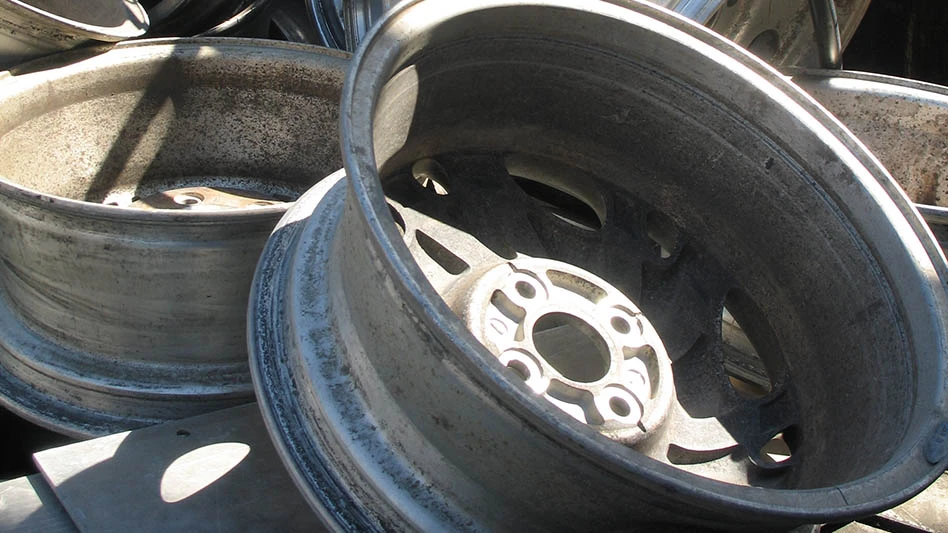Tire recyclers don’t necessarily need additional technological breakthroughs.They don’t need bigger trucks or more powerful shredders. What they do need are people in the office with marketing plans, sharp adding machines and a way to promote their product to a willing buyer.
That’s the consensus of a number of recyclers and consultants who have followed the market for more than a decade. Good processing technology is available. While the regulatory arena could use some stability, the place where most recycling operations fail is in the marketing.
"It is all related to marketing," says Corny Snyder,
JaiTire sells into three main markets, providing material for playgrounds, horse
MAKING PLANS. Mac McPherson, CEO of Mac’s Tire Recyclers, Saltillo, Miss. agrees. "This is the hardest thing I ever tried to sell," he says. "Once you get your marketing set up and start producing a product that the customer needs, then you can do okay."
As simple as that strategy sounds, a lot of recycling business owners miss the point. "I picked up a lot of accounts from other people who did not produce what their customer needed," McPherson says.
Mac’s is a regional recycler that prepares a lot of TDF (
"It’s a very hands-on business. You can’t run it from an office in a different state," warns Tom Wendt, sales manager at Wendt Corp., Tonawanda, N.Y. "Without close
The old saw that "nobody plans to fail, but many fail to plan" applies here. Nearly everyone interviewed for this feature agrees that going into new markets could be profitable for those who know where they are going. Snyder points to the success of programs to market crumb rubber for roads in California.
"There is a reason my company is not called Colorado Tire Recycling," Snyder says. She says that calling a company by its own business function (like recycling) is a mistake. "Give your company an unusual name, market your end product or market what your customer does," she advises.
Snyder also says doggedness is an important factor for success in the tire recycling game. "There is such a tremendous failure rate," she says. "It takes tenacity—I’ve stuck through some tough times these past 12 years."
"Those who are not successful have no concept of the marketing of the product," says Wendt, whose company sells equipment to U.S. tire recyclers and crumb rubber processors. "Success depends on your ability to produce a quality product and to deliver on time."
TODAY’S MARKET. In 2003, 232 million tires were processed or shipped by recyclers, according to the Rubber Manufacturers Association (RMA), Washington. The cement industry was the biggest consumer of whole tires, taking about 40 million. This leaves about 192 million tires for processing.
SEPARATE WAYS |
Equipment makers are responding to tire recyclers’ requests to help them produce clean grades of crumb rubber and marketable steel radial tire wire. One of these new pieces of equipment comes from Denmark’s Eldan Recycling and Wendt Corp., Tonawanda, N.Y., sells it in the United States. The Eldan Heavy Rasper (right) takes tires down to 0.75 inch or smaller and produces a 99.9-percent-wire-free product, according to the companies. Columbus McKinnon (CM) of Sarasota, Fla., has introduced the CM Liberator, has been under development and testing for more than three years. The machine is designed to produce rubber and steel materials with "unmatched cleanliness." Depending on the feed material and screen size, the Liberator can produce rubber that is 99 percent free of steel content, according to the company. Machines like The Grizzly from Granutech-Saturn Corp., Grand Prairie, Texas, take tire shreds down to a uniform size, improving magnetic separation capability. "The results of that improvement are a rubber product that is consistently better than 90 percent free of all steel and an enhanced level of granulator efficiency," the company says. |
While some 6 million to 8 million tires are in inventory, the remaining volume made for a good supply for processors.
TDF is the single largest market, consuming 130 million tires in 2003, up from 115 million in 2001.
While more tires are being processed, fewer companies are doing the processing. The mom-and-pop operations of 15 years ago are evolving into large corporations.
McPherson says anyone who wants to work in the market at any level needs experience. "Go work for someone for a year," he advises. "Don’t ever go into a business where you don’t know what it is about.
"Go to an area where you can get plenty of merchandise and where there are no other shredders," McPherson says. "Get close to your end user." He notes that all sorts of operations, from paper mills to cement plants, will burn TDF.
"Find the customer and give them what they want," McPherson says.
One of the big stumbling blocks in TDF is allowing too much wire (from the radial tires) in the material. This creates problems at the user’s end. "I believe the wire-free market is heating up," Wendt says.
Mac’s recycling operation started out as an adjunct to the family tire store. "A necessary evil," he says. In 1989 they were generating about 100 scrap tires per day. The county stopped accepting them at landfills, and he had to do something with them.
He quickly found out that others had the same problem disposing of tires. The operation grew from three trailers a week in 1989-90 to 150 to 200 tons daily today.
Currently, his TDF fetches $15 per ton. He also is looking at other markets to break
THE REGULATORY SIDE. Many people who look at the crumb rubber or TDF markets are blinded by the promise of state-supported laws and the lure of the tipping fees. After all, how can one lose in a market where someone else actually pays you to take raw materials from them? In every other business—from restaurants to steel mills—the processor pays for inputs and has to add value to make a profit. In tire recycling, someone pays the recycler to take old tires.
"People get faked out by the tipping fee," Snyder says. She also says that the promise of government help is typically a hollow one. "The states say they want to help, but when it comes down to it, they walk away," Snyder says.
Regulation is a mixed bag. "It is not a problem when a state has regulations, but [it is] when it does not have good regulations or
He says a point of contention for legitimate recyclers is when some of their competitors do not play by the rules. He notes that a permitted hauler, with a bond, is at a disadvantage to a wildcatter who does not have a license or a bond.
As the market evolves into a statewide or a regional one with fewer, larger producers, the remaining processors must deal with different regulations from state to state. That patchwork of regulations—the lack of consistency—is another problem. "It’s like the hole in a donut—the bigger the hole, the less donut you get," Blumenthal says.
He sees two holes in the rubber donut: sunsetting of legislation and raids on state tire funds. Many states passed laws regulating and funding tire programs a decade or so ago. These regulations face sunset reviews…in some cases, the law will stay on the books, but the funding will expire.
Sponsored Content
Still relying on manual sorters?
Let AI do the heavy lifting. Waste Robotics delivers reliable, high-performance robots tailored for complex waste streams. They require minimal maintenance, are easy to operate, and are designed to boost your recovery rates. Smarter sorting starts with the right partner. Waste Expo Booth #1969 & REMA #2843
Click here to see our robots in action!"When the funds go away, many not-so-good things happen," Blumenthal says.
More disturbing to the RMA is the frequency with which states are going into the locked box of tire funds, taking the money and using it for other uses. Blumenthal says 15 or 16 states have had their funds raided. For example, in New
TOMORROW’S MARKETS. Some markets are more sustainable than others. Snyder credits that to the gross margin on a product. A typical TDF operation is operating at $10-$30 per ton. If the tipping fee goes down a dime, the cost of material must go up $10 to cover it.
"My products run $300 to $800 per ton," Snyder says. "If the tip fee goes down 10 cents, I also raise my cost by $10. But it is a lot different going from $700 to $710 for a product as opposed to going from $30 to $40. Long term, we have better gross margins."
Traditional processors stick to passenger car tires. The larger truck and off-road tires can put a lot more wear and tear on a piece of equipment.
Snyder says the big market of tomorrow is civil engineering. She says a company that markets big chunks of rubber as lightweight landfill or bridge embankment fill can do well.
Typically, this market produces a product that is a bit larger than the average TDF product. Because the tires are
Blumenthal says the TDF market is hot, noting the increased consumption. Growth is thanks to higher gas, oil and coal prices. The pulp and paper and commercial boiler industries cannot get enough. With TDF costing between $1 and $4 per million BTUs of power, and with traditional fuels at $10 per million BTUs, it is easy to see the attraction.
"The trend is
Landscape uses are growing, too. New equipment that produces a product between the size of crumb rubber and a 1.5-inch shred has opened doors for marketers. The machines are cheaper than a cracker mill. With sizes in the 0.5-inch to 0.75-inch area, a recycler can remove the wire, take out the fluff and produce a product appropriate for horticultural, playground and other uses.
In any business, there always seems to be a "gotcha." In this
Still, opportunities abound. "Those companies that produce a consistently high-quality product at a competitive price will do well," he concludes. "But keep in mind that you have to have the demand and identify where the demand is going."
The author is a Recycling Today contributing editor based in Cleveland. He can be contacted at curt@curtharler.com.
Get curated news on YOUR industry.
Enter your email to receive our newsletters.

Explore the October 2004 Issue
Check out more from this issue and find your next story to read.
Latest from Recycling Today
- Steer World offers PEX plastic recycling machine
- New recycling grant program launches in Massachusetts
- Tire Recycling Foundation names executive director
- Dock 7 named 2025 Exporter of the Year at New Jersey International Trade Awards
- Waste Connections reports ‘better than expected’ Q1 results
- Commentary: How EPR is transforming the packaging industry
- Acerinox names new North American Stainless CEO
- Greenwave closes 2024 books with red ink








